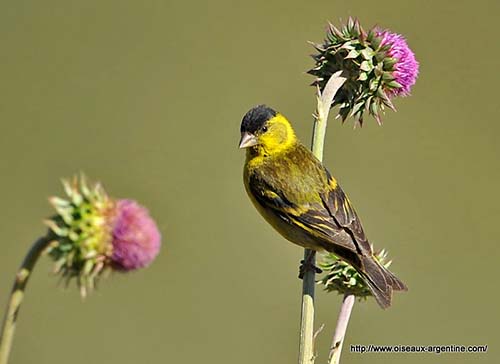
Fr: Chardonneret à menton noir
All: Bartzeisig
Esp: Jilguero Golinegro
Ita: Lucherino mentonero
Nd: Zwartkinsijs
Sd: Sydsiska
Photographers:
John Anderson
John Anderson Photo Galleries
Eduardo Andrés Jordan
MIS AVES – AVES DE ARGENTINA
Philippe et Aline Wolfer
GALERIE
Text by Nicole Bouglouan
Sources:
HANDBOOK OF THE BIRDS OF THE WORLD Vol 15 by Josep del Hoyo-Andrew Elliot-David Christie - Lynx Edicions – ISBN: 9788496553682
BIRDS OF SOUTH AMERICA – Passerines - by Robert S. Ridgely and Guy Tudor – HELM Field Guides – ISBN: 9781408113424
Ottaviani, M. (2008) Monographie des Fringilles (fringillinés – carduélinés) – Histoire Naturelle et photographies, Volume 1. Editions Prin, Ingré, France, 488 p.
Ottaviani, M. (2011a). Monographie des Fringilles (carduélinés) – Histoire Naturelle et photographies, volume 2. Editions Prin, Ingré, France, 286 p.
Ottaviani, M. (2011b). Monographie des Fringilles (carduélinés) – Histoire Naturelle et photographies, volume 3. Editions Prin, Ingré, France, 320 p.
BirdLife International (BirdLife International)
Black-chinned Siskin
Spinus barbata
Passeriformes Order – Fringillidae Family
INTRODUCTION:
The Black-chinned Siskin is a bright-coloured bird of South America and Falkland Islands. It frequents forests and edges, and often forms vocal flocks when feeding on the ground. In the Falkland Islands, it is usually found in tussock grass and areas with some trees or shrubs.
This is a typical Neotropical siskin with yellow plumage and black head.

DESCRIPTION OF THE BIRD:
Biometrics:
Length: 12-13 cm
Weight: 13-20 g
The adult male has greenish-yellow to olive upperparts finely streaked blackish. Rump and uppertail-coverts are yellower. The tail is blackish with bright yellow bases to outer rectrices. The upperwing is black with two yellow wingbars and patch on primaries.
The underparts are bright yellow with some green wash on flanks. The belly is whitish. The undertail-coverts are pale yellowish and tipped dark.
On the head, forehead, crown, upper nape, lores, chin and centre of throat are black. The face is olive, slightly tinged yellowish. The lower nape is olive-green. The ear-covert area is yellow tinged green.
The conical bill is blackish with pale base to lower mandible. The eyes are dark brown to black. Legs and feet are flesh-brown.
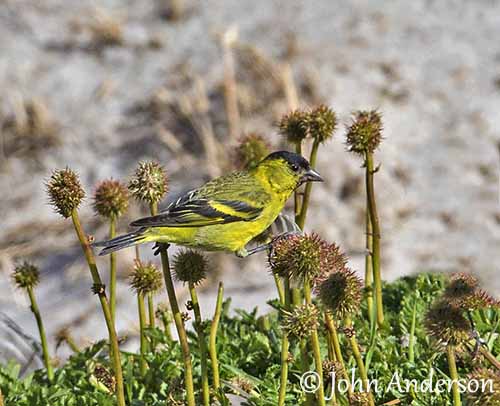
The female is duller. She lacks the black on the head. Her plumage is more greyish above and she has indistinct pale yellow supercilium. The underparts are dull yellowish with whitish mid-belly. The wing pattern is similar to that of male, with duller yellow markings.
She also occurs in grey morph, with greyer plumage above and below, and much duller yellowish supercilium.
The juvenile resembles female but it is paler with narrow, but heavy darker green streaking. It is duller than female overall, including the head.
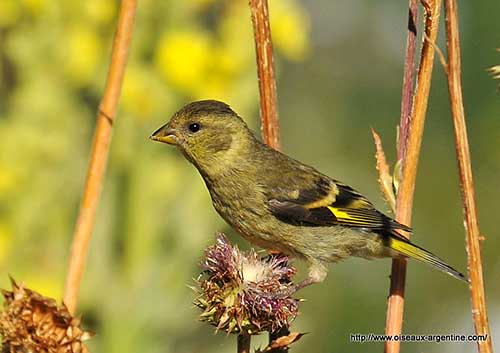
RANGE:
The Black-chinned Siskin is found in C and S Chile, S Argentina and Falkland Islands.
HABITAT:
The Black-chinned Siskin frequents forests and woodlands, high forest, forest borders, wooded areas, thickets, brush, gardens, open country with scattered shrubs and low vegetation. It can be seen around towns and along roadsides in some parts of the range. It is visible up to 1500 metres of elevation.
In Falkland Islands, it is restricted to dense tussac grass areas with Poe flabellata, and settlements with plantations of trees and shrubs, and mainly gorse.
CALLS AND SONGS: SOUNDS BY XENO-CANTO
The Black-chinned Siskin’s calls include a rising “tsooeet”, an abrupt sparrow-like “chit” and a softer “tsi-tsi-tsi”. In flight, it utters a short “chup”.
It sings from exposed perch and especially during the breeding season. The display flight is accompanied by loud, musical phrases and trills.
The songs of most of typical carduelines are usually described as varied, rapid, buzzy, melodious, and composed of twittering, warbling and trills.
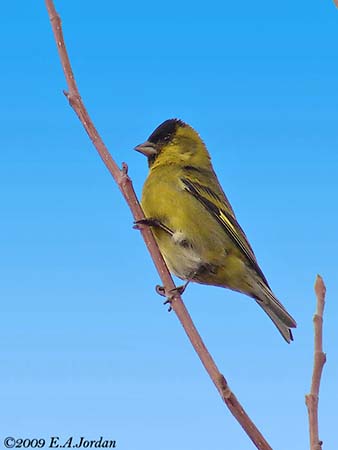
BEHAVIOUR IN THE WILD:
The Black-chinned Siskin feeds primarily on seeds from various plant species, but it also takes insects and their larvae, and probably berries.
This species forages at all levels from ground to tree canopy. This is an active and agile bird, often perching on tall grasses and tussac to reach and extract the seeds.
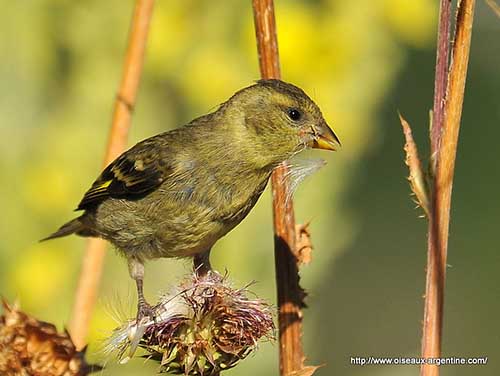
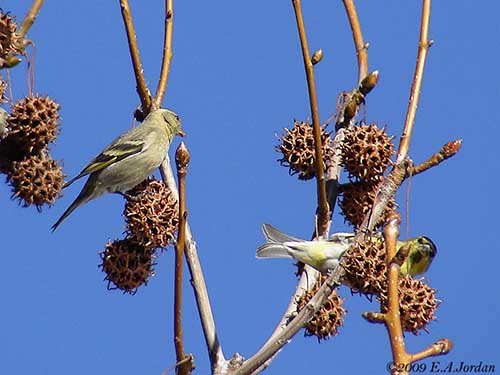
It is usually seen in pairs or in small groups, but outside the breeding season, it may occur in larger flocks of up to 100 individuals, and also in mixed-species flocks with the Hooded Siskin.
During the breeding season, only a small area around the nest is defended. They usually spend little time on territorial defence.
Courtship starts as male and female still are in a flock. The male performs mild aggression towards other males and sings loudly. It adopts ritual postures in front of the female, until touching her bill. Ritualized aggression towards the female is exhibited in the early weeks of pair formation. It raises the wings away from the flanks to enhance their bright-coloured pattern. The bill is pointed upwards and then, the wings are drooped to expose the rump and tail colours. A moth-flight display is often performed prior to copulation.
During the pair formation and after, the mates stay together and the male typically accompanies the female wherever she goes. It stays close to her while she builds the nest too. The male performs “mate-guarding” until she starts to incubate. Then, it leaves her and forages for both of them. It usually feeds her by regurgitation at nest.
The Black-chinned Siskin may perform altitudinal movements and reaches lower plains and valleys within the range according to food availability.
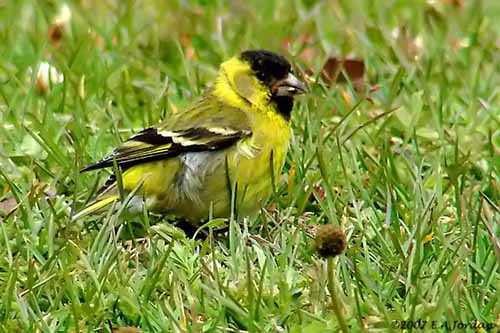
REPRODUCTION OF THIS SPECIES:
The breeding season occurs between July/August and February. In Falkland Islands, this species usually produces three broods.
The nest is a cup made with fine grasses, roots and vegetal fibres. It is lined with down and sheep wool. It is placed above the ground, at about two metres in tree branch and shrubs, or in thick tussac grass on Falkland Islands.
The female lays 3-5 pale eggs with dark spots between September and December (on Falkland Islands). She incubates alone while the male feeds her at nest. The incubation lasts 12-13 days. The chicks are fed on insects by both parents. They fledge about two weeks after hatching.
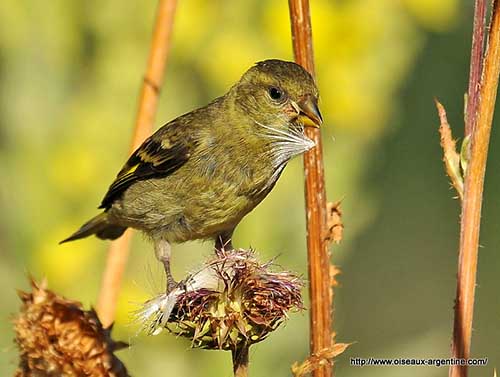
PROTECTION / THREATS / STATUS:
The Black-chinned Siskin is affected by habitat loss in Falkland Islands (about 1000 breeding pairs), due to overgrazing which destroys tussac grass areas.
This species is relatively common throughout the range in South America, but some decrease of population could be the result of cagebird trade, because this bird sings very well with melodious voice, and people likes its songs.
But currently, the Black-chinned Siskin is evaluated as Least Concern.